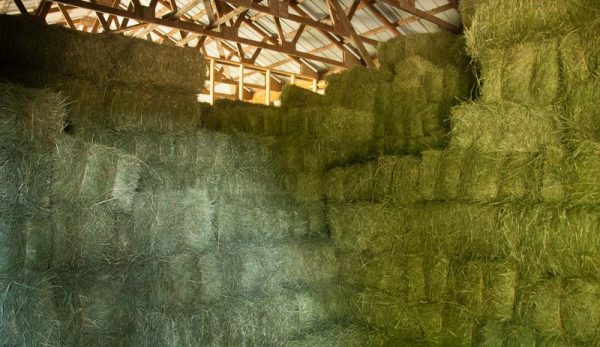
Stacking square hay bales is more than just a skill—it’s practically an art form. If you try to research the best way to stack square bales, you’ll run into a lot of conflicting approaches and ideas.
There are many different ways to stack square bales. One way isn’t necessarily better than another. The different approaches offer varying strengths and weaknesses, just like different styles of art.
I won’t claim to be a Rembrandt or a Picasso in the art of stacking square bales. But having handled tens of thousands of bales through the years, I do have a handful of tips for how to stack your square hay bales.
Read more: Square or round bales—which is right for you?
Bale layers should be stacked in alternating, interlocking fashion.
If there’s one thing virtually all farmers agree on, it’s that each successive layer of bales should be placed perpendicular to the layer underneath, forming an interlocking grid.
Suppose the bottom layer is arranged so the long side of each bale is parallel with a north-south line. The next layer up in the stack would turn the bales 90 degrees so the long sides are parallel to an east-west line.
This interlocking approach ties stacks of bales together in larger, more stable groups. This decreases the chance the stack will lean (or topple) as it grows taller.
The bottommost bales should be stacked on their sides.
To increase airflow, it’s recommended that at least the bottommost layer of bales should be stacked on their cut sides, in such a way that the baling twine does not touch the floor. All subsequent layers can then be stacked flat with the baling twine facing up.
Another option is to maintain the side-stacked orientation throughout the entire stack. In addition to promoting airflow, some folks say this approach reduces issues with rodents chewing through baling twine.
But I find it difficult to walk on side-stacked bales (particularly if they’re baled loose and fluffy). Walking across bales is a necessity when stacking more than five or six layers high. So I favor the flat-stacked approach for the firmer footing it provides.
The length of each bale will affect your stack.
Why is bale length important? Well, if each bale is 18 inches wide by 36 inches long, they’ll fit together snugly when stacked in alternating, interlocking fashion. Two of the 18-inch short ends, stacked side-by-side, will match the 36-inch long end of bales in adjacent layers.
But maybe you don’t want your stack super-snug. To promote airflow, a slightly more open stack can be beneficial.
If your bales are 18 inches wide by 38 inches long, you’ll have to leave two-inch gaps between adjacent bales in each layer to keep the stack square. For very large stacks, this approach could potentially decrease stability.
But for shorter stacks, I haven’t found it to be an issue. And the benefits gained from improved airflow are certainly worth pursuing.
Read more: Should you measure hay by the bale or by volume?
Stacking against support walls can be helpful.
Building a square stack is the key to maintaining stability as the height increases. But this is easier said than done.
Adding one whole layer at a time can help, especially if you construct the outer perimeter of the layer first. That way, everything meshes together securely at the corners.
Hay bales aren’t always consistent in terms of size or shape, though. This is particularly true if you’re baling them loose and fluffy. As your stack grows, it can become difficult to keep everything square, level and secure.
For these reasons, it can be helpful to stack hay in an area enclosed on at least three sides—even if some of the sides are just temporary wooden studs reaching from floor to ceiling, partitioning off part of a larger space.
By stacking right up against these straight and rigid support walls, you’ll give the entire haystack something solid to lean on. This buys more margin for error if your bales refuse to stack neatly.
You should still seek to stack securely. But adding support walls to the mix can simplify the process and increase safety, too.
On a related note, the height of a haystack should not exceed its width by more than 50 percent. If the base of your stack measures 20 feet long by 20 feet wide, the height should be limited to 30 feet or less.
If you construct a tall stack on top of a narrow base, you’re asking for the stack to lean or fall in one direction or another.
Let us know who you prefer to stack your square hay bales!




